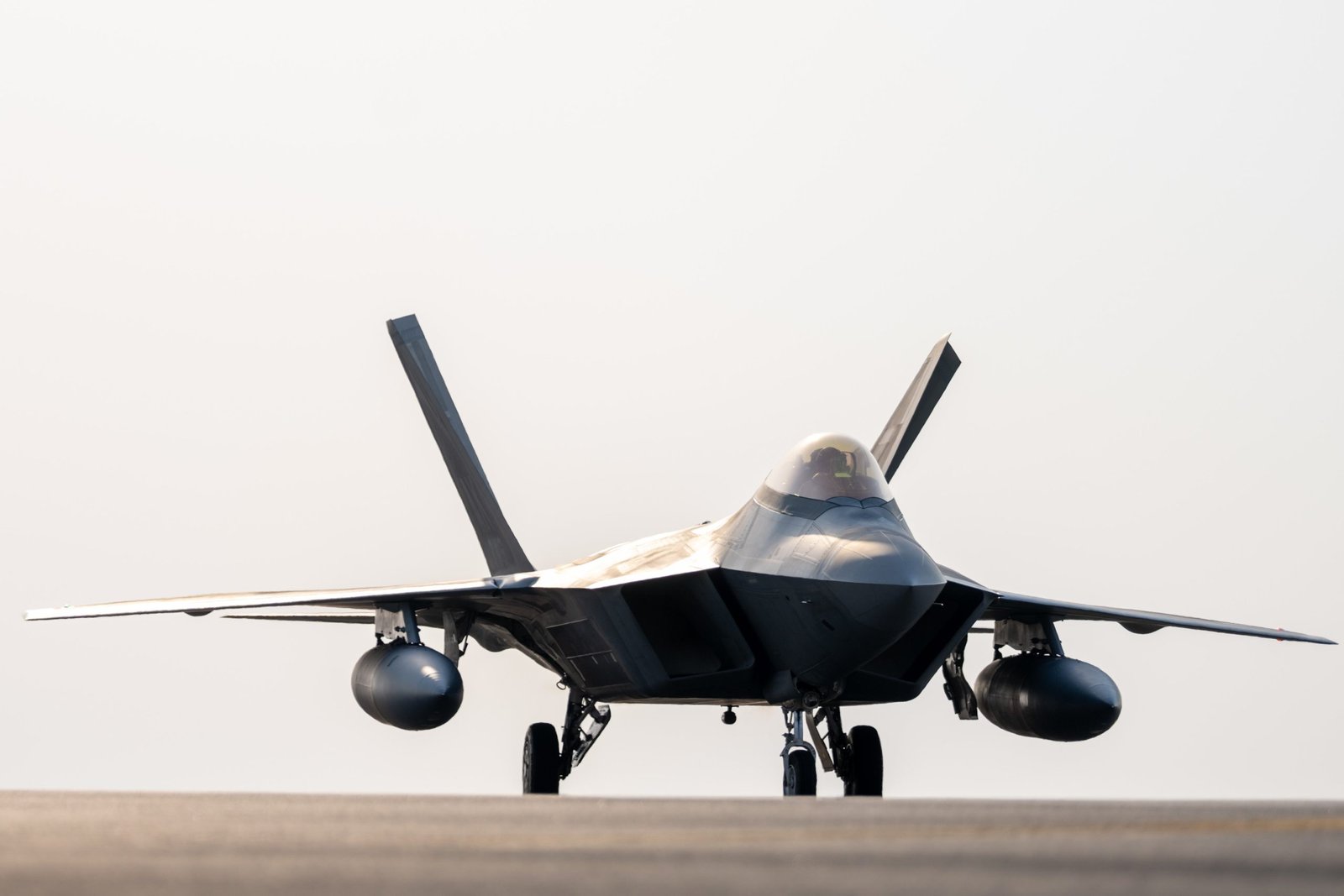Air Force F-22 Raptors are now in the Middle East “to address threats posed by Iran and Iranian-backed groups” against Israel, U.S. Central Command announced Aug. 8.
The Pentagon added U.S. forces in the region after Iran vowed to avenge the Jan. 30 killing of Hamas political leader Ismail Haniyeh by a bomb smuggled into the house in Tehran where he was staying. Iran says the attack was carried out by Israel, which has not publicly claimed responsibility.
Iran’s promised retaliation could include direct strikes from its territory and indirect attacks through its proxy forces. Iranian-backed Lebanese Hezbollah, which controls southern Lebanon and the Lebanese border with Israel, may also launch attacks. In recent days, U.S. forces in Iraq have experienced harassing rocket attacks from Iranian-aligned militia there.
The F-22s are the most advanced fighter aircraft among a rapid infusion of fresh forces in the region, including U.S. warships capable of shooting down ballistic missiles. The U.S. may also bolster land-based ballistic missile defenses in the region.
Around a dozen F-22s arrived at a base in the Middle East from Joint Base Elmendorf-Richardson, Alaska, U.S. officials told Air & Space Forces Magazine. Covering a distance of more than 5,600 nautical miles, the F-22s made the trek across North America and the Atlantic Ocean, stopped at RAF Lakenhealth, U.K., and then traveled across the Mediterranean Sea. They reached their temporary home in the region with the help of tanker aircraft on Aug. 8.
A spokesperson for Air Forces Central (AFCENT) declined to say where the F-22s or any other U.S. fighters in the region are based, citing operational security.
The additional military firepower is intended to fend off or deter an attack from Iran and its proxies on Israelis. It is also intended to better defend U.S. troops.
“The United States will not tolerate attacks on our personnel in the region,” Secretary of Defense Lloyd J. Austin III during a press conference on Aug. 7. “We’ve adjusted our military posture to strengthen our force protection and to reinforce our ironclad commitment to the defense of Israel and to remain prepared to respond to any contingency.” Austin said an additional fighter squadron to the Middle East would “reinforce our defensive air support capabilities there.”
The F-22 is the Air Force’s premier, fifth-generation air superiority fighter.
“They can be a very invaluable defensive platform,” Deputy Pentagon Press Secretary Sabrina Singh said of the deployment of F-22s to the Middle East. “They add a maneuverability [and] additional systems that allow the commander to have more versatile options. And I think it sends a very clear signal to the region that we want to see tensions de-escalate. And it sends a really powerful message of deterrence.”
A rocket attack on Al Asad Air Base, Iraq, on Aug. 5 injured four U.S. service members and two U.S. contractors, Singh said Aug. 8. U.S. defense officials originally said seven Americans were injured. The Pentagon has attributed the attack on Al Asad to an Iranian-aligned Shia militia group.
Since October, when Hamas launched its attack on Israel, there have been 180 attacks on U.S. troops in Iraq, Syria, and Jordan, according to the Pentagon. Three Soldiers were killed in an attack on Tower 22 in Jordan, which supports the Al Taft Garrison in Eastern Syria. The U.S. conducted an airstrike in Iraq on a one-way attack drone facility used by an Iranian-aligned militia on July 30.
Hamas’ Oct. 7 attack on Israel killed 1,200 people and the group took 250 hostages. Israel responded with a prolonged attack on Hamas in Gaza with the stated purpose of destroying Hamas. The campaign has resulted in the deaths of nearly 40,000 Palestinians in Gaza, according to Palestinian health officials, whose numbers do not distinguish between combatants and civilians.
The F-22s’ arrival in the Middle East comes days after the U.S. Navy flew about a dozen F/A-18 Super Hornets from the aircraft carrier Theodore Roosevelt to an air base in the region, bringing the fighters closer to Israel and to U.S. forces stationed in Iraq, Syria, and Jordan. The F/A-18s’ relocation is temporary, U.S. officials told Air & Space Forces Magazine, and the jets will return to the Theodore Roosevelt before it departs the U.S. Central Command (CENTCOM) operating theater in roughly a week. The aircraft carrier Abraham Lincoln is en route from the Pacific to replace the Roosevelt.
F/A-18s can operate from either land or an aircraft carrier. The advantage is that land bases support flight operations around the clock, while aircraft carriers typically conduct air operations just 12 hours a day. The Roosevelt is operating in the Gulf of Oman, a much greater distance from Israel.
The F-22s add to substantial U.S. Air Force assets already in the region, including:
- F-15Es in the region are from the 335th Fighter Squadron deployed from Seymour-Johnson Air Force Base, N.C.
- F-16s from the 110th Fighter Squadron deployed from Aviano Air Base, Italy.
- A-10s from the 107th Fighter Wing at Selfridge Air National Guard Base, Michigan.
The U.S. has also moved more aerial refueling tankers to the Middle East to support the bulked-up airpower, U.S. officials said.
In April, U.S. Air Force fighters shot down more than 80 drones launched by Iran against Israel, contributing to a highly successful allied defense that neutralized some 300 missiles and drones launched by Iran. Among the U.S. jets in the April 13-14 operation were F-15Es from the 335th Fighter Squadron. The A-10s now in the region have only limited air-to-air capability, but they can threaten surface forces on land and even ships at sea.
“These posture adjustments add to our already broad range of capabilities in the region, and we remain ready to deploy on short notice to meet evolving threats to our security, our partners or our interests,” Austin said.
The Theodore Roosevelt has been in the region for the past month having diverted from the Pacific. The USS Wasp, an amphibious assault ship that also carries fixed-wing aircraft, along with its Amphibious Ready Group and onboard Marine Expeditionary Unit, is operating in the eastern Mediterranean.
“I’ve been focused on is making sure that we’re doing everything we can to put measures in place to protect our troops and also make sure that we’re in a good position to aid in the defense of Israel if called upon to do that, so you’ve seen us do a number of things to strengthen our force posture,” Austin said. “I’m in constant communications with my commanders in the region and also with our allies as well. So we’ll see how this evolves.”




















